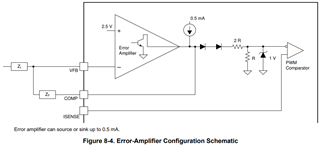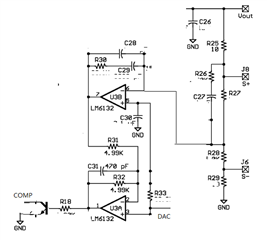Other Parts Discussed in Thread: TL431, , OPA336, OPA337, LM5025
Hi Team,
In my design, I need to develop a flyback converter with an adjustable output voltage using an analog signal provided by a DAC. In a previous question that I asked here, I was advised to implement compensation using an external op-amp so that I could utilize this analog reference signal as my voltage source reference voltage. However, I was informed that this external compensation circuit must have an open collector configuration to be directly compatible with the UC's Comp pin. My question pertains to how to create this external compensation circuit with an open collector output. I have searched for relevant documentation, but most of them utilize a TL431 and an optocoupler, which do not support an adjustable reference voltage. Additionally, it's important to note that the voltage source I'm developing should not be isolated. Could you assist me with any documentation or provide a basic schematic of how this external compensation with a variable reference voltage would work?
Thank you.





